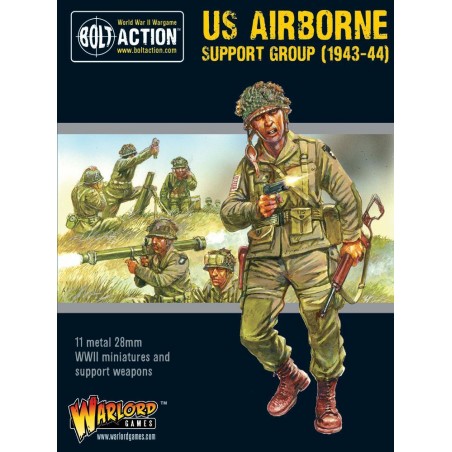- On order
- -15%




Delivered in time for Christmas? Order only products marked ‘In stock’ before 14 December.Learn more


This set contains:
1 x US Airborne HQ
1 x US Airborne Medium Machine Gun Team
1 x US Airborne Medium Mortar Team
HQ
American forces began the war with no combat experience and often with minimal training. Once exposed to the realities of warfare, both officers and men learned quickly. However, the constant demand for troops meant that relatively inexperienced officers could still find themselves leading men into action, even by the end of the war. Both experience and promotion often came rapidly, whether in Europe or the Pacific.
Medic
The field medic presented the wounded soldier with the best chance of surviving serious injury and ensured that lightly wounded soldiers were returned to fighting fitness as quickly as possible. Junior medical staff, such as stretcher-bearers, could accompany medics in the field. Medical officers were not always armed, but in practice, a pistol was often carried for self-defense.
Medium Machine Gun
The Americans were equipped with an excellent medium machine gun: the Browning M1919A4 .30-cal. Due to its weight (31 lbs), it was always used with a tripod. It had a rate of fire of 500 rounds per minute and an effective range of over 1,000 meters. Paratrooper squads could carry the M1919A6 – a version of the Browning .30-cal. machine gun fitted with a lightened barrel, stock, and bipod, in an attempt to provide a squad light machine gun.
Bazooka
The American Bazooka was first used in North Africa and at Tarawa in November 1942. The first version (M1A1) had two grips and a wooden support. By 1943, a new version was released, which no longer had the front grip but featured an improved electrical firing system. The final version was longer (1.55m) and increased the range from 200–250 yards to 300 yards. The M6 HEAT rocket could easily penetrate 76mm of armor at 30° or 110mm at 90°.
Light Mortar (M2)
Mortars were the most commonly available type of support weapon. Paratroopers and Rangers had one mortar per platoon, in addition to those assigned at the company level. They were generally deployed in a suitable rear position, no more than 100 yards from the observer, to "cover the most dangerous approaches to the platoon area." The standard light mortar was relatively large-caliber at 60mm. It fired a correspondingly larger and more effective shell over a greater range than the smaller mortars used by the Germans and British. The only issue was the weight (19kg), meaning a larger team was needed to move it. Paratroopers used a lighter version (the M19 weighing only 9kg).
Models supplied unassembled and unpainted.
Viewed products